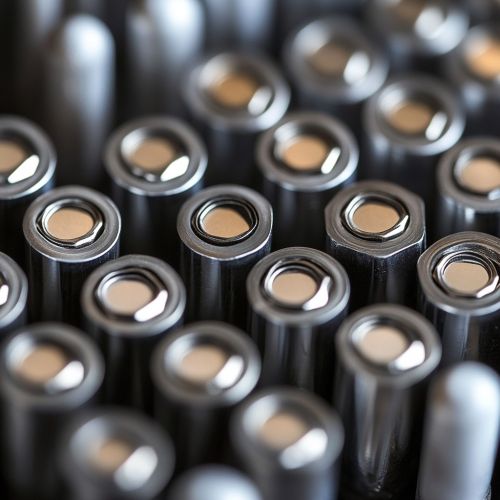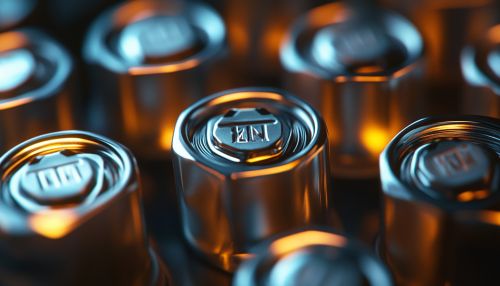Nickel–zinc battery: Difference between revisions
No edit summary |
No edit summary |
||
| Line 52: | Line 52: | ||
* [[Solid-state battery]] | * [[Solid-state battery]] | ||
[[Image:Detail-98065.jpg|thumb|center|Close-up image of a nickel–zinc battery cell.]] | [[Image:Detail-98065.jpg|thumb|center|Close-up image of a nickel–zinc battery cell.|class=only_on_mobile]] | ||
[[Image:Detail-98066.jpg|thumb|center|Close-up image of a nickel–zinc battery cell.|class=only_on_desktop]] | |||
== Categories == | == Categories == | ||
Latest revision as of 01:26, 22 September 2024
Introduction
A nickel–zinc battery (NiZn battery) is a type of rechargeable battery that uses nickel and zinc as its primary components. NiZn batteries have been known for over a century but have gained renewed interest due to their potential for high energy density, long cycle life, and environmentally friendly characteristics.
History
The concept of the nickel–zinc battery dates back to the late 19th century. Thomas Edison was one of the early pioneers who experimented with this chemistry. However, early versions of NiZn batteries faced significant challenges, such as short cycle life and poor stability, which limited their commercial viability. Advances in materials science and manufacturing techniques in recent decades have addressed many of these issues, leading to a resurgence in interest.
Chemistry and Mechanism
NiZn batteries operate on the principle of electrochemical reactions between nickel and zinc. The positive electrode (cathode) is typically made of nickel hydroxide (Ni(OH)₂), while the negative electrode (anode) is composed of zinc (Zn). The electrolyte is usually a potassium hydroxide (KOH) solution.
Electrochemical Reactions
The overall cell reaction during discharge can be represented as: \[ \text{Ni(OH)}_2 + \text{Zn} \rightarrow \text{NiO(OH)} + \text{Zn(OH)}_2 \]
During charging, the reaction is reversed: \[ \text{NiO(OH)} + \text{Zn(OH)}_2 \rightarrow \text{Ni(OH)}_2 + \text{Zn} \]
The nickel electrode undergoes oxidation and reduction, while the zinc electrode undergoes dissolution and deposition.
Performance Characteristics
NiZn batteries are known for their high energy density, which is typically higher than that of nickel–cadmium (NiCd) batteries and comparable to nickel–metal hydride (NiMH) batteries. They also offer a high power density, making them suitable for applications requiring rapid discharge and recharge cycles.
Voltage and Capacity
The nominal voltage of a NiZn cell is approximately 1.6 volts, higher than the 1.2 volts of NiCd and NiMH cells. This higher voltage can be advantageous in certain applications, allowing for fewer cells in series to achieve a desired voltage.
Cycle Life
One of the main challenges historically faced by NiZn batteries was their limited cycle life. Modern advancements have significantly improved this aspect, with some NiZn batteries now achieving over 500 charge-discharge cycles.
Applications
NiZn batteries are used in a variety of applications, including:
- Consumer electronics: NiZn batteries are used in devices such as digital cameras, flashlights, and remote controls.
- Electric vehicles: Their high power density makes them suitable for use in electric bicycles and scooters.
- Renewable energy storage: NiZn batteries are used in solar and wind energy storage systems due to their environmental benefits and long cycle life.
Advantages and Disadvantages
Advantages
- **High Energy Density**: NiZn batteries offer a higher energy density compared to NiCd and NiMH batteries.
- **Environmental Friendliness**: Unlike NiCd batteries, NiZn batteries do not contain toxic cadmium, making them more environmentally friendly.
- **High Power Density**: Suitable for applications requiring rapid discharge and recharge.
- **Higher Voltage**: The higher nominal voltage can reduce the number of cells needed in series for certain applications.
Disadvantages
- **Cycle Life**: Although improved, the cycle life of NiZn batteries can still be shorter than that of some other rechargeable battery types.
- **Self-Discharge**: NiZn batteries can have a higher self-discharge rate compared to other rechargeable batteries, which can be a disadvantage for certain applications.
Future Prospects
Research and development in NiZn battery technology continue to focus on improving cycle life, energy density, and reducing costs. Advances in electrode materials, electrolyte formulations, and manufacturing processes are expected to further enhance the performance and commercial viability of NiZn batteries.
See Also


